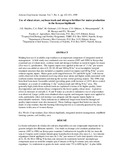Use of wheat straw, soybean trash and nitrogen fertiliser for maize production in the Kenyan highlands

View/
Date
1999Author
Okalebo, JR
Palm, CA
Gichuru, M
Owuor, JO
Othieno, CO
Munyampundu, A
Muasya, RM
Woomer, PL
Language
enMetadata
Show full item recordAbstract
Making best use of available crop residues is an important component of integrated nutrient
management. A field study was conducted over two seasons (1997 and 1998) in Kenya that
examined use of wheat straw, soybean trash and nitrogen fertiliser as nutrient inputs for maize
(Zea mays L.) production. The organic inputs were applied at the rate of 2 t ha-1 per season
and urea was added at rates of 0, 20, 40, 80 and 100 kg N ha-1 in an incomplete factorial
treatment structure that also included a complete control (no inputs) and 80 kg N ha-1 as urea
without organic inputs. Maize grain yield ranged between 751 and 6836 kg ha-1 with lowest
yields observed in the treatment receiving wheat straw alone and higher yields associated with
soybean residue incorporation and during the second, wetter growing season. The 1998 crop
benefited from more favourable rainfall, providing grain yield increase of 141% above control
treatment as a result of combining 2 t ha-1 soybean trash and 100 kg N ha-1 urea. The
generally high yields from soybean trash are explained in terms of its higher quality, faster
decomposition and nutrient release compared to the lower quality wheat straw. A positive
effect in increases of soil pH, C, N and P status as a result of cumulative use of crop residues
was observed. Larger yields were obtained when organic and inorganic inputs were applied to
soils, particularly when soil moistue was adequate and the organic inputs higher in
mineralisable nutrients. Early indications of additional longer-term benefits through soil
quality improvement were also measured. These findings suggest that better use may be
made of crop residues than the burning following harvest as is currently practiced by many
farmers in this area of western Kenya.
